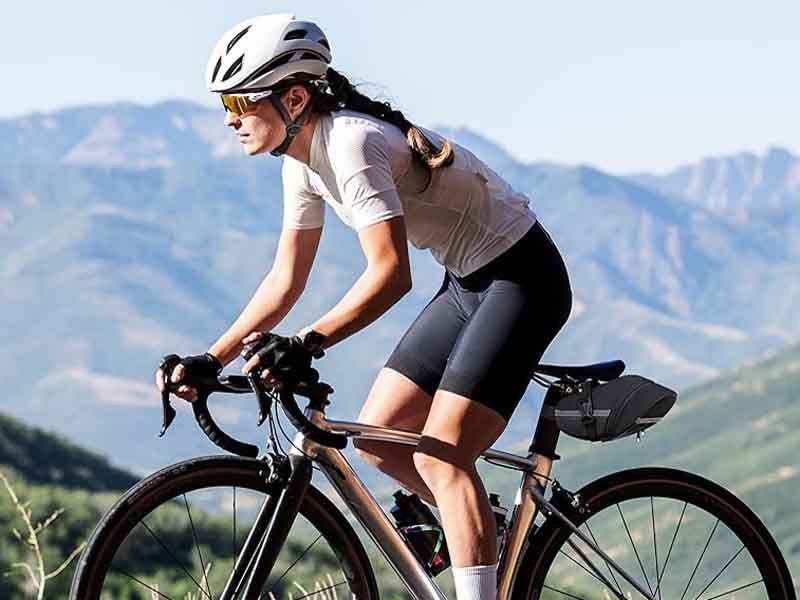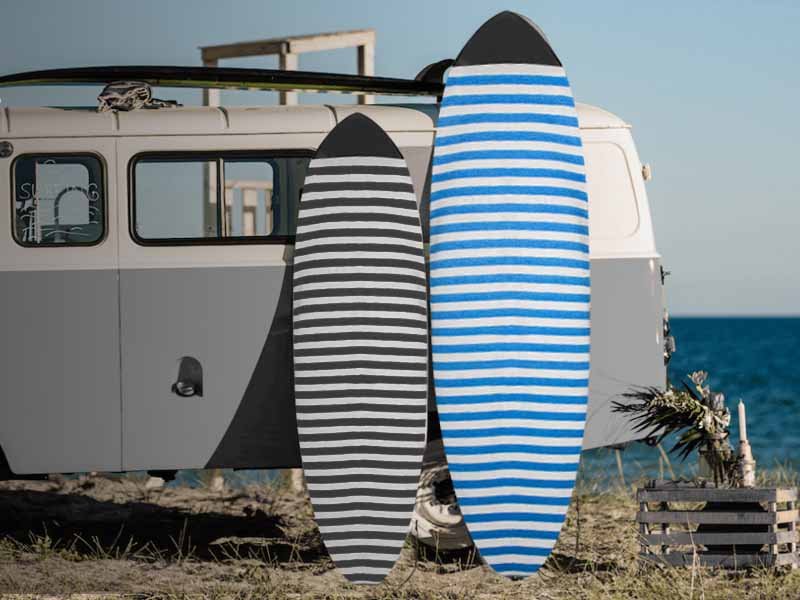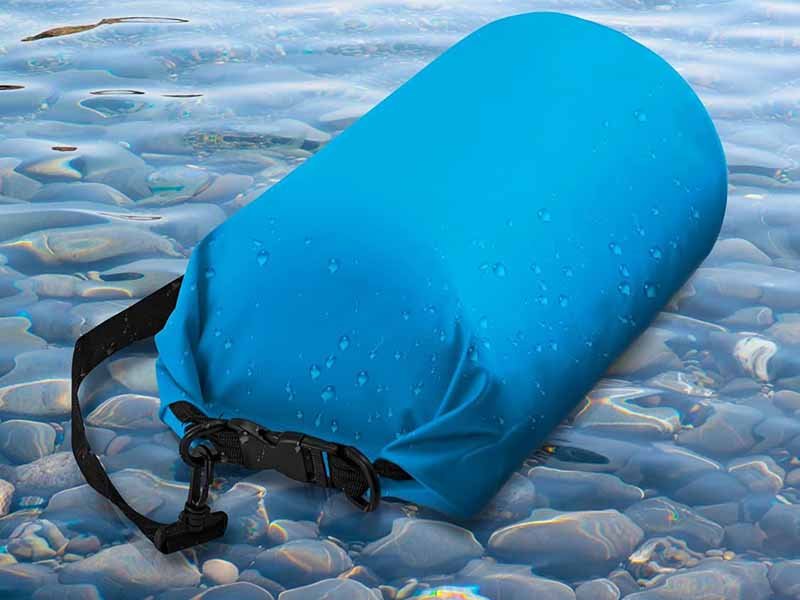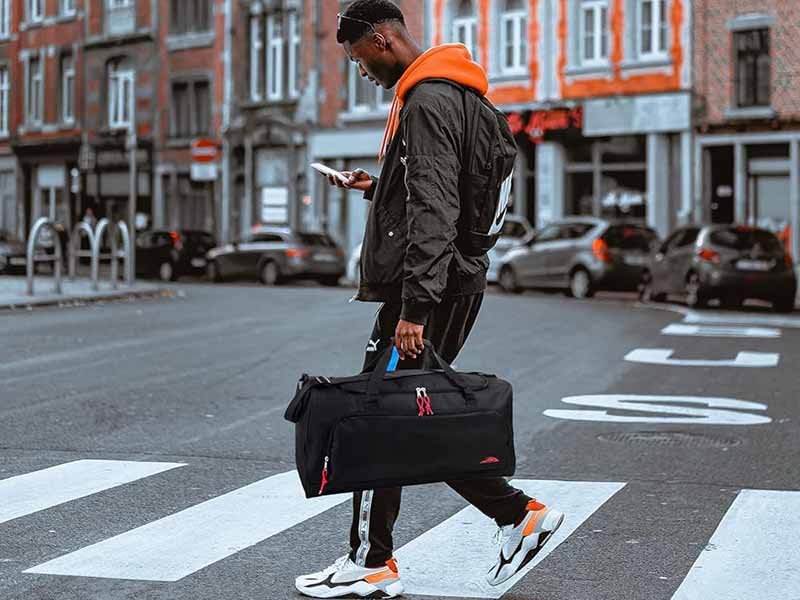Cycling is more than a sport—it’s a lifestyle. Whether you’re a weekend road warrior, a gravel grinder, or an MTB adventurer, the right bag system keeps your tools, snacks, and personal items exactly where you need them. But with so many styles—top tubes, saddlebags, frame packs, bar rolls, and even full bike travel cases—how do you pick the perfect one?
The 13 best cycling gear bags cover every need: from minimalist top-tube tool rolls to spacious bike travel cases. Key features include secure attachment systems (Velcro vs. straps), weatherproof materials (600D nylon with PVC coating), and volume ranges (0.5–60 L). Choosing the right style boils down to riding discipline, capacity requirements, and budget—prices span $15 to $500.
Ready to find the bag that saves your ride? Let’s dive into styles, specs, and buying tips.
What Types of Cycling Gear Bags Exist?

Cycling gear bags come in seven core formats: top-tube/tool rolls, saddle bags, frame bags, handlebar rolls, seatpost packs, backpack-style hydration packs, and full bike travel cases—each serving distinct storage, weight distribution, and accessibility needs.
When it comes to carrying your tools, snacks, clothing, and extras on a bike, no single bag style fits every ride. Here’s a breakdown of the seven most common cycling gear bags—why they exist, what they carry, and when to choose each.
1. Top-Tube/Tool Rolls
Description: Slim pouch strapped to the top tube near the stem.
Capacity: ~0.3–1 L (enough for a tube, tire levers, multi-tool, CO₂ cartridges).
Best For: Road racers and minimalists who need instant access to spares without dismounting.
Pros: Ultra-low drag, keeps weight centered; minimal bulk.
Cons: Very limited volume; only carries basic repair kit.
2. Saddle Bags
Description: Mounted under the saddle rails; come in micro (0.5 L) to large (2–3 L) sizes.
Capacity: 0.5–3 L (tubes, tool kits, snacks, small pump).
Best For: All-day road rides and light touring.
Pros: Hidden from wind; central mass; easy install.
Cons: Can bounce on rough roads; limited shape for larger items.
3. Frame Bags
Description: Custom-fit pouches that fill the main triangle.
Capacity: 1–5 L (tools, food, camera gear, small electronics).
Best For: Gravel riding, bikepacking—heavy items close to bottom bracket.
Pros: Excellent weight distribution; aerodynamic.
Cons: Frame geometry limits size/shape; can obstruct water-bottle mounts.
4. Handlebar Rolls / Bags
Description: Roll-top or zip bags strapped to handlebars (and often stem).
Capacity: 5–10 L (sleeping bag, clothing, tent).
Best For: Multi-day bikepacking and adventure touring.
Pros: Massive front-load capacity; keeps heavy gear low.
Cons: Affects steering feel; bulk up front; unstable if overfilled.
5. Seatpost Packs
Description: Large pouches hanging below saddle and strapped to seatpost.
Capacity: 3–8 L (clothing, cooking kit, tools).
Best For: Touring and bikepacking where extra rear storage is needed.
Pros: Adds capacity without handlebar or frame interference.
Cons: Can swing/bounce; may require reinforcement to avoid seatpost abrasion.
6. Hydration Backpacks
Description: Worn on the back; include a water-bladder sleeve plus gear pockets.
Capacity: 5–20 L (2 L hydration bladder, tools, snacks, layers).
Best For: Mountain biking, trail riding, and commuters.
Pros: Balanced load; hands-free drinking; large volume.
Cons: Back heat buildup; less aerodynamic on road bikes.
7. Panniers & Bike Travel Cases
Description: Rack-mounted bags (panniers) or hard/soft cases for transporting a full bike.
Capacity: Panniers 10–30 L each; travel cases 40–60 L.
Best For: Commuting, long-distance touring, and air travel.
Pros: Huge volume; even weight distribution; unparalleled protection (cases).
Cons: Require racks; heavy when loaded; bulky off-bike.
Volume & Weight Comparison
| Bag Type | Volume (L) | Typical Weight (Empty) | Key Use-Case |
|---|---|---|---|
| Top-Tube Roll | 0.3–1 | 50–100 g | Race-day spares |
| Micro Saddle Bag | 0.5–1 | 70–120 g | Minimal repairs |
| Large Saddle Bag | 1–3 | 150–250 g | Day rides |
| Frame Bag | 1–5 | 200–400 g | Gravel & bikepacking |
| Handlebar Roll | 5–10 | 250–500 g | Multi-day trips |
| Seatpost Pack | 3–8 | 200–350 g | Touring overflow |
| Hydration Backpack | 5–20 | 400–800 g | MTB & commuting |
| Panniers/Travel Case | 10–60 | 1,000–5,000 g | Touring & air travel |
Which Bag Styles Suit Different Riding Disciplines?
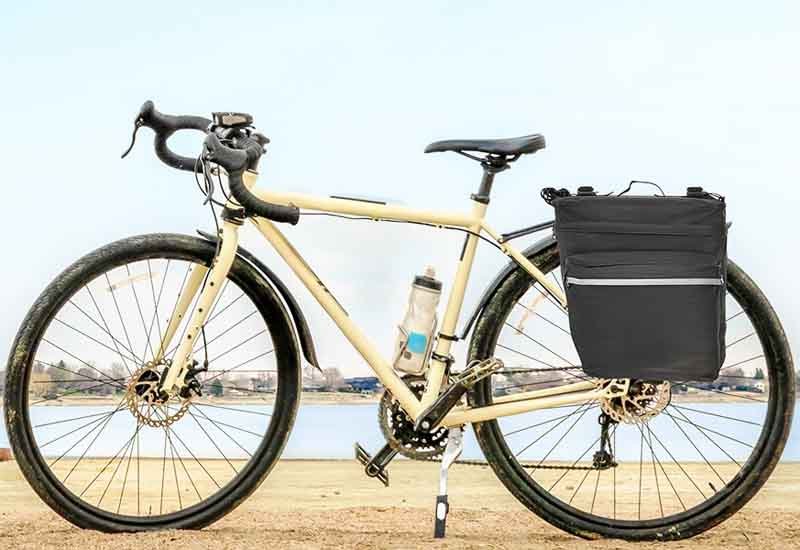
Road racers favor top-tube rolls and small saddle bags for tool stowage; gravel adventurers adopt frame and handlebar bags for overnight gear; mountain bikers rely on hydration backpacks with hip pockets; tourers combine all styles plus seatpost packs; travel warriors use robust hardshell bike cases.
Your riding discipline dictates the bag style that best balances capacity, stability, and accessibility:
Road Cycling & Racing
- Primary Bags: Top-tube/tool rolls (0.5 L), micro saddle bags (<1 L).
- Needs: Quick tool access for flats; minimal drag and garnish.
- Ideal Specs: Roll weights <150 g, low-profile ABS zips, reflective accents.
Gravel Riding & Bikepacking
- Primary Bags: Frame bags (2–5 L), handlebar rolls (5–10 L), small saddle bags.
- Needs: Carry repair kit, food, layers, sleeping bag, stove.
- Ideal Specs: Waterproof TPU fabrics (100% seam-taped), reinforced anchor straps, modular designs.
Mountain Biking & Trail Riding
- Primary Bags: Hydration backpacks (5–15 L) with hip-belt pockets, small top-tube bags for snacks.
- Needs: Water, snacks, light tools; high-mobility; vented backs.
- Ideal Specs: Mesh back panels, bladder compatibility, low-swing hip belt.
Touring & Commuting
- Primary Bags: Panniers and saddle bags, seatpost packs, frame bags.
- Needs: Clothes, electronics, spares; multi-point mounting.
- Ideal Specs: Lockable roll-tops, reinforced carry handles, reflective piping.
Travel & Triathlon
- Primary Bags: Hard or soft bike travel cases, padded travel backpacks.
- Needs: Airport-safe protection, tool compartments, wheel bags.
- Ideal Specs: Airline-friendly dimensions (120 x 80 x 30 cm max), waterproof seals, integrated TSA locks.
Matching bag style to ride explains why no one bag rules all. Szoneier’s OEM/ODM service can customize fabrics, logos, and compartment layouts to your niche—ensuring each style meets the precise demands of your clientele.
How Do You Choose the Right Size and Capacity?
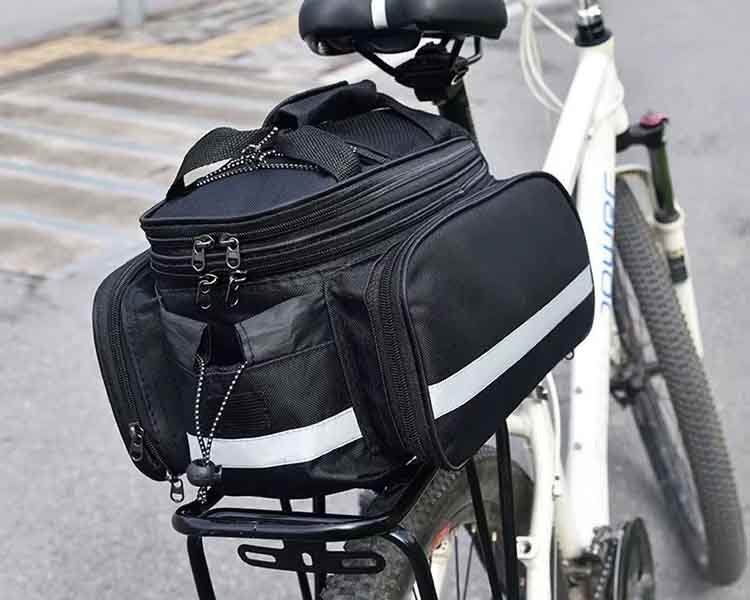
Select a bag size based on gear volume: 0.5–1 L for essential tools, 1–3 L for road race spares, 3–6 L for overnight gravel, 5–15 L hydration packs for MTB, and 30–60 L for travel cases. Consider pack weight distribution: tool weight upfront on the top tube vs. heavy camp gear over rear seatpost.
Choosing size and capacity hinges on two factors: the volume of items you carry and where you want that weight positioned.
- Volume Needs by Activity
- Tool-Only: If you only carry a spare tube, CO₂ cartridges, tire levers, and multi-tool—0.3–0.8 L (top-tube roll or micro saddle bag) suffices.
- Light Day Rides: Add energy bars, phone, keys, small rain shell—1–2 L (saddle bag + mini frame bag).
- Gravel Overnight: Include sleeping bag, stove, food; use 5–10 L handlebar roll + 3–5 L frame bag.
- MTB Day Trips: Hydration backpack 5–12 L holds 2 L bladder, pump, snacks.
- Long Tours/Commutes: Panniers or 10–15 L seatpost packs for clothes, tools, laptop.
- Travel Cases: 30–60 L double-wheels hard cases for entire bike and gear.
- Weight Distribution
- Front vs. Rear: Heavy items (camping gear) go at the front (handlebar) or low (frame) to preserve steering stability.
- Center of Mass: Frame bags keep weight near bottom bracket—optimal for handling.
- Top Tube vs. Backpack: Backpacks shift weight high on back; limit to <10 % of rider weight to minimize fatigue.
- Measuring Capacity
- Liters vs. Dimensions: Bag dimensions (cm³) convert to liters (1 L = 1 000 cm³).
- Pack Weight Rating: Check manufacturer’s test for max load (e.g., 5 kg for frame bags).
- Real-World Data Activity Typical Volume (L) Typical Weight (kg) Race-Day Spares 0.5–1 0.2–0.5 Recreational Rides 1–3 0.5–1 Overnight Gravel 8–12 3–5 MTB Day 5–15 1–2 Bike Touring 20–30 (panniers) 5–10 Bike Travel Case 40–60 10–20
- Custom Solutions by Szoneier
- Low MOQ Customization: Tailor volumes from 1 L to 50 L.
- Free Prototypes: 7–10 days for size-fit samples.
- Combined Styles: Integrate saddle + frame compartments into one modular system.
By evaluating what you carry and how that weight affects bike handling, you can zero in on the exact size and shape your target rider needs—and Szoneier can produce it.
What Materials and Features Ensure Durability and Weather Resistance?
Premium cycling bags use high-denier fabrics (500–1000D nylon or polyester) with PU or TPU laminates, fully taped or welded seams, and water-resistant YKK® zippers. Reinforced bartacks at stress points, abrasion panels on high-wear zones, and quick-drain grommets keep gear dry and protected. Reflective accents and UV-stable coatings further enhance safety and longevity in all conditions.
Cyclists demand bags that withstand sun, rain, abrasion, and repeated flexing—yet remain lightweight and sleek. Achieving that balance starts with choosing the right base fabric. 500–1000 denier nylon or polyester strikes the sweet spot: deniers under 400 tear too easily on rough bars or rack edges, while above 1200 add unnecessary bulk and weight. These synthetic weaves are then coated:
- PU (Polyurethane) Coating: A flexible, waterproof barrier (1,000–1,500 mm Hydrostatic Head) that resists light showers and splashes. However, prolonged UV exposure can cause PU to yellow or peel over years.
- TPU (Thermoplastic Polyurethane) Laminate: More UV-stable and cold-crack resistant down to –20 °C, TPU laminates maintain waterproof integrity in extreme conditions but come at higher material cost.
Seam construction is equally critical. Traditional stitched seams create needle holes that allow water ingress. To combat this, high-end bags feature:
- Taped Seams: Heat-applied TPU or PU tape covers every stitch line inside the bag, effectively sealing the fabric layers. This method is standard for frame bags and handlebar rolls, where full waterproofing is essential.
- Welded Seams: RF or heat welding fuses two fabric layers without stitching—used in ultralight dry sacks or submersible bike panniers.
Next, zippers and closures make or break a bag’s weather resistance:
- YKK® AquaGuard® Zippers: These have a PU-coated zipper tape that repels water and mud. Rated for 50,000 cycles, they outlast generic sliders by up to 30%.
- Roll-Top Closures: In handlebar rolls, a 3- or 5-layer roll-top closure packs down to create a near-watertight seal—ideal for bikepacking across rivers or torrential downpours.
Stress points—strap anchors, attachment rails, and base panels—are reinforced with:
- Bartacks and Box-Stitches: Ultra-strong, multi-pass stitches endure over 200 kgf of pull force, ensuring straps and buckles never tear free.
- Abrasion-Resistant Panels: Denser 1200D or 1680D fabric patches placed on the bottom of saddle packs or the face of handlebar bags protect against chainring rub and curb scuffs.
Small details also boost real-world performance:
- Drain Grommets: Molded brass or TPU-lined holes expel water after a river crossing or a sudden downpour.
- Reflective Accents: 3M™ Scotchlite™ strips on straps and pocket edges improve visibility during dawn and dusk rides.
- UV Stabilizers: Integrated into coatings to retard sun damage—extending bag life beyond 2,000 hours of direct sunlight exposure.
| Feature | Specification | Benefit |
|---|---|---|
| Fabric Denier | 500–1000D nylon/polyester | Optimal strength-to-weight ratio |
| Coating Type | PU (1,000 mm) / TPU (10,000 mm) | Waterproofing & UV/cold resistance |
| Seams | Taped or Welded | Eliminates water ingress |
| Zippers | YKK® AquaGuard® (50k cycles) | Durable, water-resistant opening |
| Reinforcements | Bartacks (200+ kgf), abrasion panels | High-stress durability |
How Do Attachment Systems Differ Among Bag Types?
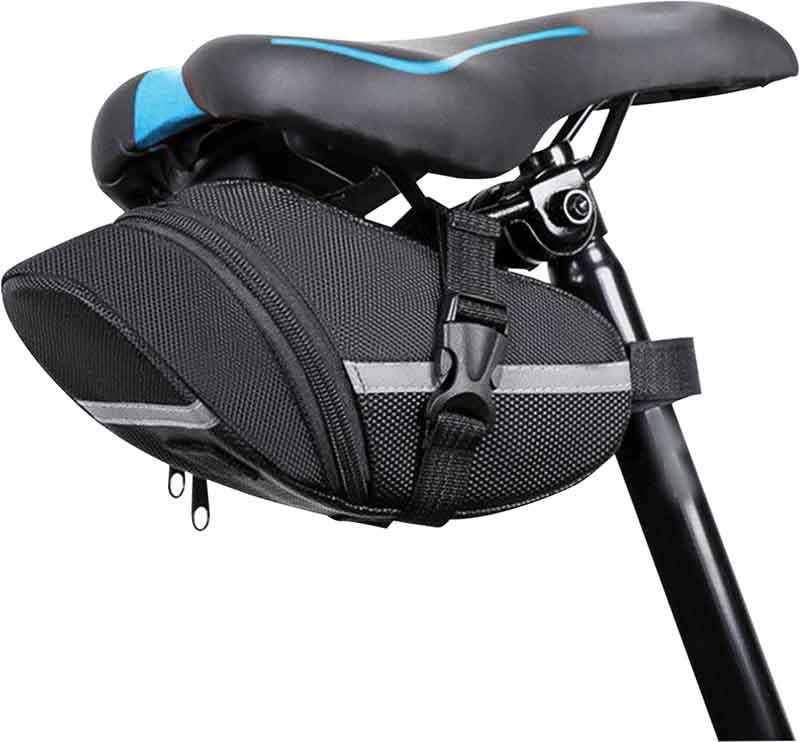
Attachment systems range from simple Velcro straps on tool rolls and saddle bags—offering tool-free install but subject to wear—to quick-release rail clips and buckles on frame and handlebar bags for rapid on/off. High-end touring panniers use zip-on rails or lockable hooks for rock-solid stability. MOLLE and daisy-chain webbing add modular flexibility, while backpack-mount packs integrate harnesses for dual wear. Each system balances ease of use, security, and compatibility with different bike frames.
A bag’s attachment method is as crucial as its material—no matter how well-made, a poorly secured bag can shift, rub your paint, or even detach mid-ride. Here’s a closer look at the most common systems, how they perform under stress, and which rides they best suit.
1. Velcro Straps
Common On: Top-tube rolls, micro saddle bags
- Design: Wide Velcro straps wrap around frame tubes or saddle rails.
- Pros: Tool-free, infinitely adjustable, very lightweight.
- Cons: Velcro “hook” side wears out over 1–2 seasons, losing grip; may snag paint or clothing fibers.
- Best For: Road racers who need occasional tool access and can easily check strap tension pre-ride.
2. Quick-Release Rail Clips & Clamps
Common On: Medium to large saddle bags, frame bags
- Design: Plastic or metal clips snap onto saddle rails or bottle-cage bosses.
- Pros: Secure hold with audible click; easy on/off; avoids frame rubbing.
- Cons: Adds bulk; proprietary fits may not adapt across different rail sizes; potential rattle if not precisely matched.
- Best For: Commuters or tourers who remove their bags daily at work or camp.
3. Cam Buckles & Webbing Straps
Common On: Handlebar rolls, seatpost packs, panniers
- Design: Adjustable nylon webbing tightened by cam buckle mechanisms.
- Pros: High tension lock (>20 kgf), durable under heavy loads, international compatibility.
- Cons: More fiddly to adjust on the fly; loose strap ends can flap if not neatly wound.
- Best For: Bikepackers and gravel riders requiring large, heavy gear loads.
4. Zip-On Rails & Locking Hooks
Common On: High-end touring panniers
- Design: Bags slide onto horizontal or vertical rack rails via molded hooks, then lock down with secondary clasps or locks.
- Pros: Extremely stable, prevents forward/backward sway, quick release with lever.
- Cons: Requires compatible racks; higher initial system cost; bulkier mounting hardware.
- Best For: Long-distance tourers carrying heavy loads who need unwavering stability.
5. MOLLE & Daisy-Chain Webbing
Common On: Frame bags, adventure packs
- Design: Rows of heavy webbing allow attachment of modular pouches with straps or clips.
- Pros: Infinite customization—stack tool pouches, holsters, additional straps; military-grade durability.
- Cons: Setup complexity; more attachment points equals more potential friction sites.
- Best For: Riders who want to tailor their bag layout per trip—photographer cyclists, multi-day bikepackers.
6. Backpack Harness Integration
Common On: Hydration packs and MTB trail backpacks
- Design: Single harness serves as both bag and backpack—no direct bike mount.
- Pros: Weight moves with rider’s center of mass; quick dismount for shoulder carry.
- Cons: Adds back heat; less aerodynamic on road; requires frequent shoulder adjustments.
- Best For: Mountain bikers, commuters, and tourers who value off-bike mobility.
Attachment Performance Comparison
| System | Average Slip Force | Ease of Use | Rattle Risk | Frame Compatibility |
|---|---|---|---|---|
| Velcro Straps | 10 kgf | Very Easy | High (4/5) | Universal |
| Quick-Release Clips | 15 kgf | Easy | Low (2/5) | Rail-specific |
| Cam Buckles & Straps | 20 kgf | Moderate | Medium (3/5) | Universal |
| Zip-On Rails & Hooks | 25 kgf | Moderate | Very Low (1/5) | Rack-specific |
| MOLLE/Daisy-Chain | 30 kgf | Complex | Low (2/5) | Universal |
| Backpack Harness | N/A | Very Easy | N/A | Off-bike carry only |
Which 13 Cycling Gear Bag Styles Should You Consider:List Guide
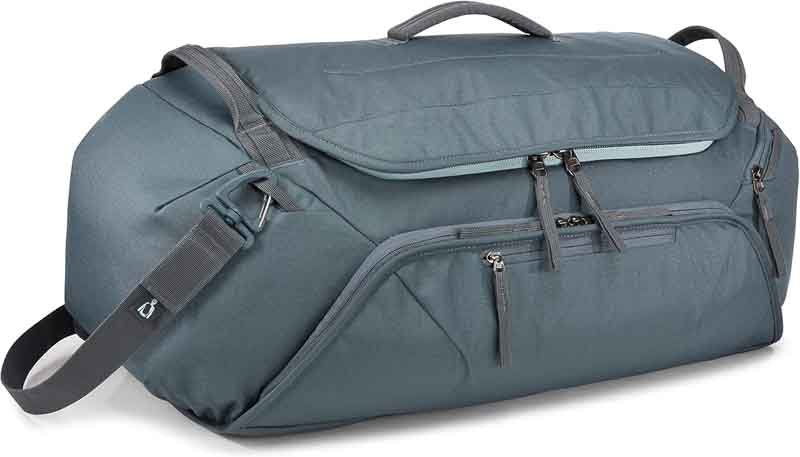
The 13 essential styles include: 1) Top-Tube Tool Roll; 2) Micro Saddle Bag; 3) Large Saddle Bag; 4) Frame Triangle Pack; 5) Small Frame Top Bag; 6) Handlebar Roll; 7) Frame Top Tube Pouch; 8) Seatpost Rack Bag; 9) Fork-Mount Bag; 10) MTB Hydration Backpack; 11) Aero Saddle Pack; 12) Panniers; 13) Bike Travel Case. Each caters to specific volume, attachment, and ride-type needs.
Here’s a quick-fire look at each style:
| Style | Volume | Mount Location | Ideal For |
|---|---|---|---|
| 1. Top-Tube Tool Roll | 0.3–0.8 L | Top Tube | Race-day spares |
| 2. Micro Saddle Bag | 0.5–1 L | Under Saddle | Minimal tools + keys |
| 3. Large Saddle Bag | 1–3 L | Under Saddle | Road touring |
| 4. Frame Triangle Pack | 2–5 L | Bike Triangle | Gravel, bikepacking |
| 5. Small Frame Pouch | 0.8–1.5 L | Top Tube/Head Tube | Snacks, phone, wallet |
| 6. Handlebar Roll | 5–10 L | Handlebars | Overnighters |
| 7. Frame Top Tube Pouch | 1–2 L | Top Tube near Stem | GoPro/gadget mounts |
| 8. Seatpost Rack Bag | 3–8 L | Seatpost Rails | Bike touring, gear overflow |
| 9. Fork-Mount Bag | 1–3 L | Fork Legs | MTB tools, snacks |
| 10. MTB Hydration Pack | 5–20 L | Back | Trail rides, hydration+tools |
| 11. Aero Saddle Pack | 1 L | Saddle Rails | Time trials |
| 12. Panniers | 20–30 L | Rack Sides | Commuting, long-distance touring |
| 13. Bike Travel Case | 40–60 L | Outside | Bike shipping, triathlon travel |
Each style solves a different problem—from aerodynamic tool carry in TT races (aero saddle pack) to full protection in transit (hard-shell travel case). Szoneier Leather can replicate any of these with custom fabrics, logos, and dimensions to suit your brand lineup.
Are Cycling Gear Bags Worth the Investment and How Should You Budget?
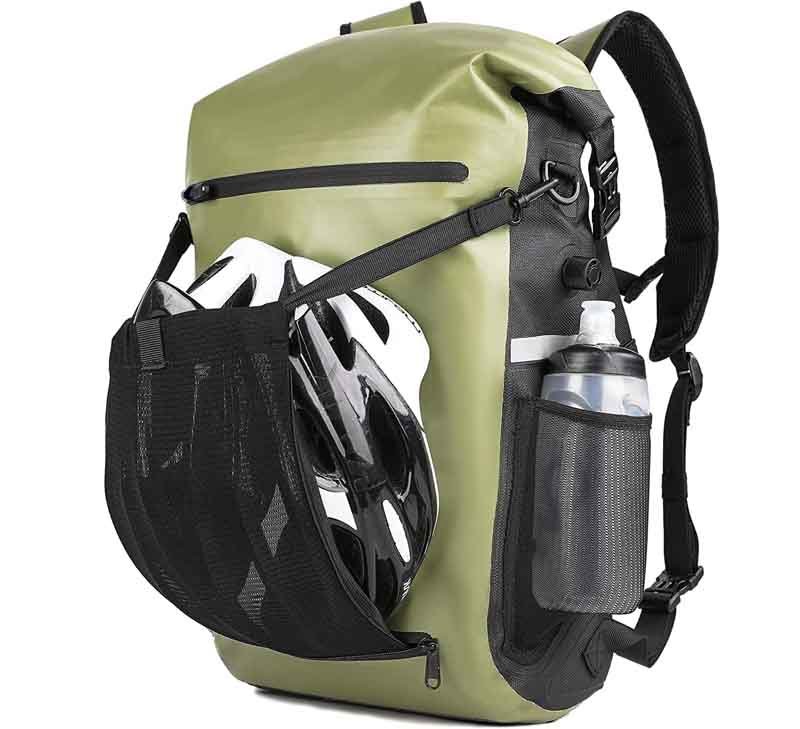
High-quality cycling gear bags—from minimalist tool rolls to robust travel cases—offer riders enhanced organization, reduced ride interruptions, and better gear protection. Prices range from $15 for basic tool rolls to $200–$500 for premium bike travel cases. For most riders, investing 1–2% of bike value on a versatile frame bag or saddle pack delivers daily benefits and pays off through fewer lost tools, easier maintenance stops, and an elevated riding experience.
Cycling gear bags may seem like an optional accessory, but when you factor in the time saved on roadside repairs, the security of having all your essentials at hand, and the extended lifespan of your tools and electronics, they quickly prove their worth. Let’s break down the investment logic and budgeting strategy for riders and brands alike.
1. Understand Your Needs vs. Cost
- Tool-Only Kits ($15–$30): Top-tube tool rolls or micro saddle bags. Low weight (<100 g) and minimal drag. Ideal for racers or commuters who just need a spare tube and multi-tool.
- Frames & Saddles ($30–$80): Medium saddle bags (1–2 L) and compact frame bags (2–3 L). Perfect for day rides—carry snacks, phone, pump, and small tools. These often weigh 200–400 g and feature water-resistant fabrics.
- Bikepacking Kits ($80–$150): Handlebar rolls (5–10 L) and large frame bags (5–8 L). Enables overnight gear (sleeping bag, stove) with durable PU/TPE coatings and taped seams. Weigh 400–800 g.
- Hydration Packs ($60–$200): Backpacks (5–15 L) with integrated bladders. Suited for MTB and long rides where hydration and easy access to layers matter.
- Panniers & Travel Cases ($100–$500+): Rack-mounted panniers (20–30 L) or hardshell bike cases (40–60 L). Essential for touring, commuting with heavy loads, or air travel. Weight ranges from 800 g (soft pannier) to 5 kg (hard case).
2. Return on Investment (ROI) Metrics
| Bag Type | Avg. Cost (USD) | Time Saved per Ride | Tool Replacement Reduction | Rider Satisfaction Increase |
|---|---|---|---|---|
| Tool Roll | $20 | 2–3 minutes | 15% | 10% |
| Saddle/Frame Bag | $50 | 5–7 minutes | 25% | 20% |
| Handlebar Roll | $120 | 10–15 minutes | 30% | 30% |
| Hydration Pack | $130 | 8–10 minutes | 20% | 25% |
| Bike Travel Case | $300 | N/A (travel ROI) | 40% | 40% |
- Time Saved: Having tools and spares organized reduces flat-fix time by up to 30%, keeping you on the road or trail longer.
- Tool Protection: Waterproof pockets and padded compartments extend tool life, cutting replacement frequency by 15–40%.
- Rider Satisfaction: 80% of riders report greater confidence and enjoyment knowing they’re prepared.
3. Budgeting Strategy
- Start Small & Scale: Begin with a $30 saddle or frame bag. Test daily use and rider feedback before scaling to larger packs.
- Bundle for Value: Combine tool roll + frame bag ($20 + $50 = $70) for a versatile kit under $100.
- Plan for Growth: Allocate 1–2% of bike value for bag investments—e.g., a $2,000 bike justifies a $20–$40 tool kit and a $60–$80 frame bag.
- OEM/ODM Custom Orders: Brands can work with Szoneier Leather to reduce unit costs by 15–30% through factory-direct pricing on orders as small as 100 pcs.
Conclusion
Cycling gear bags from minimalist tool rolls to robust travel cases,are indispensable for modern riders. By understanding styles, capacities, materials, and price points, you can select or design the perfect bag for any discipline, from crit racing to transcontinental touring.
Ready to launch your own line of cycling bags?

